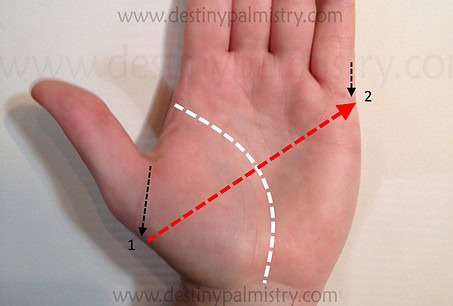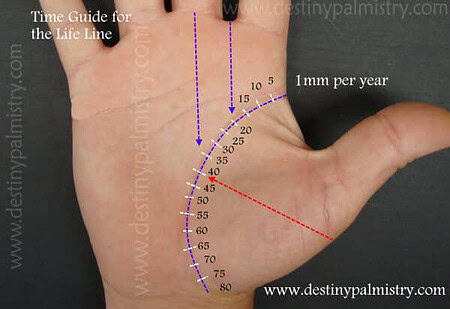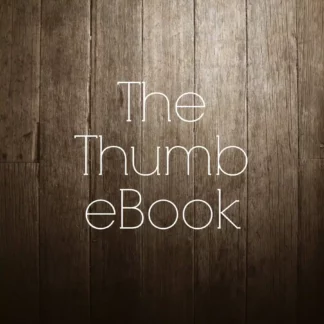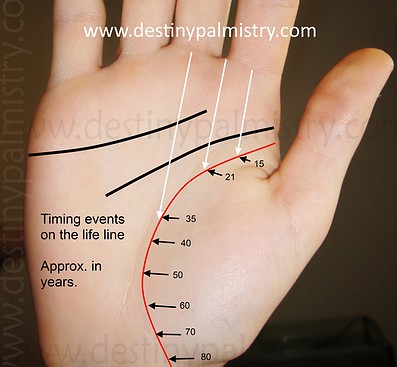
Methods of Timing on life line.
How do you do timing on the life line in palmistry? I will show you a couple of methods. The first line a person usually looks at on the palm is the line of life. It is also often the most prominent line on the palm. The life line is the crease that arcs around the mount of Venus. It generally reaches somewhere near the wrist. This line is not an indicator of how long you will live, but it shows the quality of your life.
So, the life line’s condition might depict your life’s condition. Ideally, it should be well-defined without deviations or markings. However, that is not likely to occur today due to busy and demanding lives. If the marks on the line reveal certain events, then we would be interested in guessing the timing.
There are various methods of doing this. However, it is not easy to do or an exact science. However, the timing on life line is an important part of interpreting the markings. Knowing whether an event has passed or is yet to come can prevent much unnecessary worry; some markings on this line are negative indicators.
The methods used by palmists are not exact, but the following timing on the life line example is relatively close.
The best way to find the timing of events on your life line is to look at past events. A significant move or change should show and leave a marking on the line. With practice, you get to understand the knowledge of these experiences and achieve a more accurate reading. (See what a broken life line means here.)
The beginning of the line starts at the top, and many hand readers agree that is where to begin the timing. I am open to reading it the other way around, but I chose to start at the top for this article.
When estimating the timing on the life line, approximately halfway along shows the age of forty. Not everyone has the same lifespan, but this guide gives you the average age. If, for instance, a person lives to a hundred, then halfway is fifty. The handshape can change the position of this line, so remember to think about any big events in the past that might have made a mark on the life line and use that as a guide for the age.
You can draw an imaginary line from the base of the thumb to the corner of the little finger, and in most cases, it marks the middle of the line.

Once you have established the middle of the line to depict the age, approx. forty, you can pick the halfway point on either side to point to age twenty and sixty.

Again, after getting the quarter marks, you can halve them to get the ages of ten, thirty, fifty and seventy.

More ways to estimate the timing
Another popular method, which I use a lot, is to use the fingers as a guide. This is quite accurate up to the age of thirty-five. After that point, you need to use the measuring method.
- A straight line drawn from the centre of the index finger to the life line is around the age of fifteen.
- A line straight down from the gap between the index and middle finger is the approximate age of twenty-one.
- From the centre of the middle finger, the age of thirty-five.
If a line is broken, has a broad curve, is close to the thumb or reaches out towards the moon, it can be challenging to estimate timing. As a rule, to simplify it all, the first quarter length from the beginning of the line represents the age 1-20. The second quarter is 20-40, the third 40-60 and the last 60-80.
Estimate timing by using the measuring method
If you want to try to be more exact in the timing technique, you can use the metric or imperial method. The imperial measures each year as 1/16th of an inch. The metric system is 1mm per year. They give a slightly different result, so it’s up to personal preference. Remember to think about any big events in the past that might have made a mark on the life line and use that as a guide for the age.

If you’ve enjoyed reading this post, please share it with your friends!
Please help us continue our valuable palmistry information by donating any small amount. Thank you 🙂
Watch the video about timing on the life line here for free
MY BOOK IS AVAILABLE BELOW IN PAPERBACK, HARDCOVER AND KINDLE VERSION
WEBSITE NOTICE: The author disclaims any liability or responsibility to any person or entity concerning any outcome, loss or damage caused directly or indirectly by utilising any information presented on this website and intended as point-of-view and entertainment only.
- Product on sale
 Life Guidance From the Palms and FingerprintsOriginal price was: $565.00.$503.00Current price is: $503.00.
Life Guidance From the Palms and FingerprintsOriginal price was: $565.00.$503.00Current price is: $503.00. -
 Thumb Reading eBook download pdf$10.00
Thumb Reading eBook download pdf$10.00

[…] reasons that can bring this change, so it’s nothing to worry about. You can use this timing method to try to estimate when the change will […]